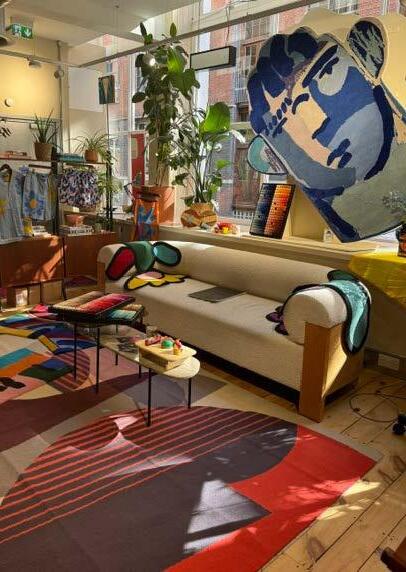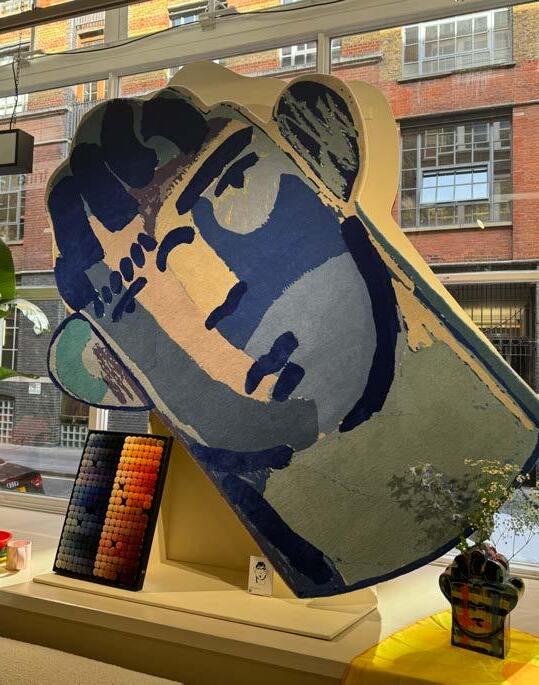

Written by Alys Bryan, Editorial Director designinsiderlive.com






Written by Alys Bryan, Editorial Director designinsiderlive.com



LONDON DESIGN FESTIVAL 2024 OPENED IT’S DOORS AND SHOWED DESIGNERS JUST WHAT’S POSSIBLE!
THIS YEAR, THE 22ND EDITION SAW THE STREETS OF LONDON TRANSFORMED INTO A HUB OF INSPIRATION, WITH HUNDREDS OF EVENTS SHOWCASING CONTEMPORARY DESIGN. WITH SO MUCH TO SEE, IT’S EASY TO FEEL LIKE YOU CAN’T EXPERIENCE IT ALL!
Despite this challenge, LDF 2024 was a tremendous success, bringing together designers, brands, and enthusiasts from around the world. The festival’s energy, innovation, and engaging conversations lit up the city, reaffirming London’s status as a design capital.
We know that even if you attended LDF, it was impossible to catch everything. This Trend Report is here to highlight what you missed, celebrate the standout moments, and join the conversation.
We’ll delve into the successes and challenges of the festival and invite you to join the discussion on our Design Insider LinkedIn or via email at alys@designinsiderlive.com
Cover image: LightMass, Raw-Edges Design Studio
This page, clockwise from top left: LDF identity by Pentagram partner Domenic Lippa, Alys Bryan, Well Made by Pearson Lloyd, Resonance by M Moser, Tolerance by Mitre & Mondays

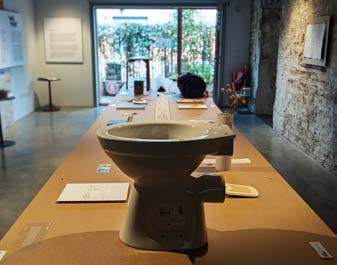

LONDON DESIGN FESTIVAL 2024 UNFOLDED ACROSS 11 DISTRICTS, EACH OFFERING AN EXPERIENCE THAT COULD EASILY TAKE A FULL DAY TO EXPLORE. THE SHEER NUMBER OF EVENTS, INSTALLATIONS, AND CREATIVE SHOWCASES ACROSS THE CITY ENSURED THAT THERE WAS AN OVERWHELMING VOLUME OF CREATIVITY TO DISCOVER. WHILE THE TRADE DAYS WERE QUIETER THAN EXPECTED, THE BUSTLING EVENING EVENTS AND FLOURISHING SOCIAL OPPORTUNITIES HIGHLIGHTED THE STRENGTH OF THE THRIVING DESIGN COMMUNITY. AS LDF CONTINUES TO EVOLVE, IT’S CLEAR THAT THERE IS POTENTIAL FOR GREATER INVOLVEMENT FROM COMMERCIAL INTERIOR SUPPLIERS, AND WE LOOK FORWARD TO FORGING OUT OUR PLACE WITHIN THIS DYNAMIC LANDSCAPE.
This year, we observed several key trends that shaped the festival. Immersive installations were a standout, incorporating movement, light, and sound to create engaging and joyous experiences.
Group concept exhibitions like Well Made by Pearson Lloyd and BLOND presented group exhibitions of creative outcomes from shared briefs, highlighting collective impact and communityfocused results rather than conventional collaboration. Well Made asked designers from various industries, locations, and life stages, ‘What does Well Made mean to you?’ a question that sparked an exciting range of insights and responses, encouraging the studio to reflect on its own evolution. Meanwhile, BLOND LABORATORY brought together seven leading industrial designers to create unique responses each reinforcing the value of hands-on creativity over digital inspiration.
Learning and process were at the forefront during London Design Festival 2024, particularly within the Brompton Design District who delivered a programme curated by Jane Withers Studio which explored The Practice of Learning and the fertile ground of knowledge gathering, experimentation and ideas exchange. Highlights included Grymsdyke Farm, who presented Reading Room following their design student
summer residency, and Making Room Space by Andu Masebo, where the journey from workshop to product took center stage.
Conceptual installations also captivated audiences, with standout works like M Moser’s ‘Resonance’ installation, which celebrates the differences in how our brains respond to environmental stimuli, and Heiter X’s foraging experience at SoShiro Gallery in the Mayfair Design District. A personal highlight was the Juicy Booth by Annie Frost Nicholson at Coal Drops Yard, which invited participants to confront and release their personal shame through an emotional interaction of light and sound—an experience that left a lasting impact.
The talks programme, particularly the Global Design Forum held at the Victoria and Albert Museum, provided thought-provoking insights and sparked conversation. One off dissuasion events provided rare opportunities to hear about design icons, and smaller showroom based talks made indepth discussion accessible across the event.
As we continue to reflect on LDF 2024, we see an evolving festival that embraces innovation, creativity, and community, while also highlighting opportunities for growth in the commercial interiors space.
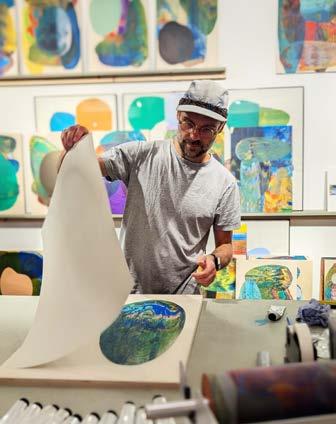

1. Daniel Eatock at SCP
2. Robin & Lucienne Day Foundation with &Tradition
3. Resonance celebration by M Moser
4. Design You Can Feel by Dezeen and ASUS
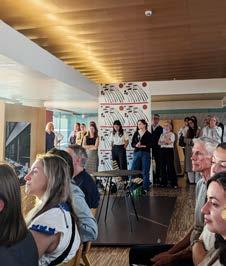

PEARSON LLOYD ONCE AGAIN SHOWCASED THEIR ABILITY TO FOSTER ESSENTIAL CONVERSATIONS IN DESIGN WITH THEIR LATEST EXHIBITION, “WELL MADE.” HELD AT YORKTON WORKSHOPS, THE EXHIBITION CHALLENGED US TO RETHINK WHAT “WELL MADE” MEANS IN TODAY’S WORLD, ESPECIALLY IN THE CONTEXT OF SUSTAINABILITY AND A RAPIDLY CHANGING ENVIRONMENT.
This exhibition builds on the studio’s previous work, including ‘Change Making’ in 2022, and last year’s acclaimed “Material Change” shared at Material Matters 2023. “Material Change” was an exploration of Pearson Lloyd’s ongoing research into improving the circularity of mass-produced products, emphasising the need for sustainable design practices. These exhibitions reflect Pearson Lloyd’s commitment to using their platform not just to display work but to drive crucial discussions.
“Well Made,” featured contributions from 60 diverse design voices, each sharing their interpretation of what “well made” means today. The result was a thought-provoking collection of objects that questioned conventional standards of quality and industry practices. From innovative production methods to sustainable material choices, the exhibition offered a forwardthinking response to the demands of a more ecological future. As Luke Pearson noted:
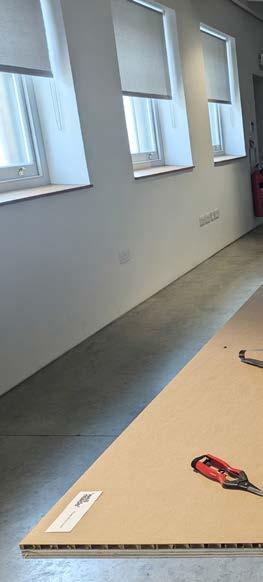
“The act of making has driven human and cultural evolution for millennia, elevating our existence through ingenuity and innovation. However, in recent history, this creative process has been monetised, industrialised, and globalised. Consequently, we are experiencing rapid social, economic, and environmental changes. In our collective effort to respond to these challenges, we must redefine our cultural understanding of what it means to be well made.”
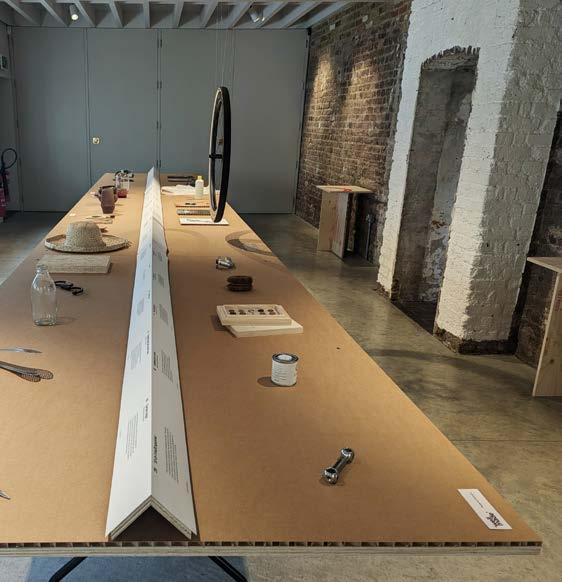
The launch event was a lively and engaging affair, sparking informal yet meaningful conversations among attendees about the role of craftsmanship, quality, and sustainability in design. We thoroughly enjoyed the diverse items on display, but it was the conversation that truly stood out, prompting us to reflect on how we define quality in an age of abundance and waste.
On the following pages we highlight 6 items. A book showcasing all 60 items is available from Pearson Lloyd with all money raised going to charity.

Manufactured by Victorinox
JASPER MORRISON
‘I’ve been using a Rex Peeler for about 25 years, and every time I do, I marvel at the cleverness of it. Made with such an economy of material and yet so perfect at it’s job and completely indestructible. Not only that but satisfying to use and pleasing to look at.’

Manufactured by Mooncup
AMY WOLFE
‘Although menstrual cups were first invented in the 1930’s, Mooncup (created in 2002) was the world’s first medical grade silicone cup. Not only do they save money, they are also better for the planet and safer to use than disposable period products.’

‘I’m fascinated by the duality of fibre optic cables. On one hand, the scientific principle of internal reflection has driven digital innovation and advancements in AI. However, the energy demands of this technology, particularly AI processes like data scraping, are having a significant environmental impact. This tension between progress and its ecological cost is something I continually reflect on.’
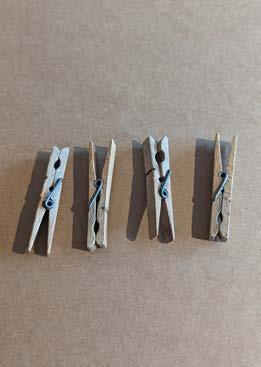
‘ This is one of those items you can’t really tell who designed it.
A tool: both the spring and wood support their tasks. Sometimes parts pop apart, but anyone can repair this. Certainly the old springs last a lifetime. I have taken hundreds from my mother-inlaw and still enjoy them.’
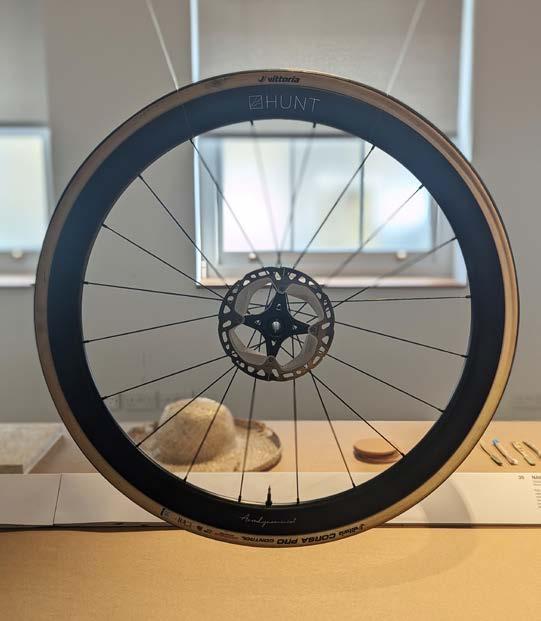
LUKE PEARSON
‘ The wheel is perhaps humanity’s most ubiquitous invention. The humble bicycle wheel represents so much about man’s ability to invent, refine and design. The wire spoked wheel was invented over 200 years ago. Since then it’s been productionised allowing it to be sold very cheaply to the masses but also optimised allowing it to convert the maximum power into motion.’
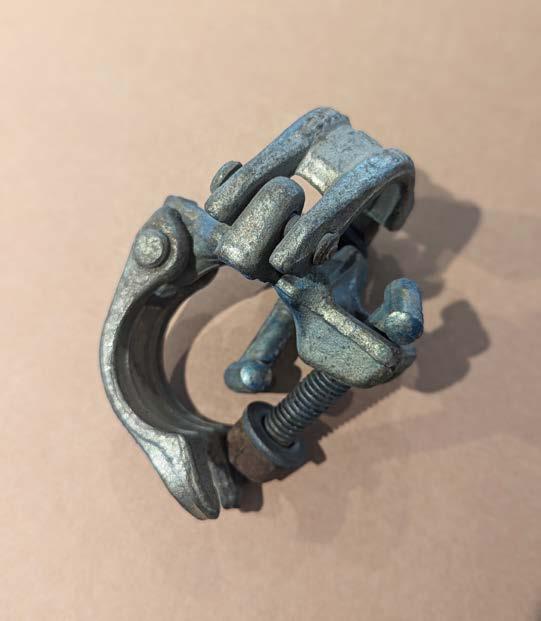
MAX FRASER
‘An essential enabler of construction, renovation and repair, scaffolding is rapidly assembled and disassembled and can be tailored to any site. The tubular extrusion is useless on it’s own yet infinitely configurable when combined and clamped. The mono-material aluminium is durable, infinitely reusable, and recyclable should it ever need to be.’
THE SHOREDITCH DESIGN TRIANGLE ONCE AGAIN STOOD OUT AS ONE OF THE MOST CONSISTENTLY EXCITING DISTRICTS OF LONDON DESIGN FESTIVAL 2024, RIVALED ONLY BY THE DYNAMIC BROMPTON DESIGN DISTRICT. CURATED AND ORGANISED BY SCP FOR THE PAST 16 YEARS, THE TRIANGLE CAPTIVATED VISITORS WITH ITS VIBRANT IDENTITY AND ECLECTIC LINEUP OF OVER 50 PARTICIPANTS, BLENDING EMERGING TALENTS AND ESTABLISHED NAMES.
Shoreditch Design Triangle featured a diverse range of exhibitors, from iconic brands like Bill Amberg and Hay to innovative newcomers such as Mitre & Mondays and The Collective. This year, attendees were greeted by eye-catching wayfinding elements, including playful toppers created by Daniel Eatock in collaboration with Farrow.
SCP, at the heart of the district, provided a platform for resident designers like Son’s of Beasley to shine, reinforcing the Triangle’s reputation as a key creative powerhouse.
One of the standout launches within the Triangle was the Wax Building, the new home for Cozmo, Tamart, and Minialux. This space also hosted the mesmerising LightMass installation by Raw-Edges Design Studio, a fusion of form, light, and sound. LightMass, true to its name, featured a series of illuminating structures that are maximal in presence but minimal in weight, demonstrating an innovative fabrication process that minimises environmental impact.
Paul Smith’s reimagining of Artek’s iconic designs was a bold and graphic installation which showcased iconic pieces in striking cobalt blue and brilliant white. Whilst on the ground floor of the Tramshed showroom Vitra launched Anagram, a new sofa system designed by Panter&Tourron.
Dezeen’s collaboration with ASUS, Design You Can Feel, also drew significant attention, spotlighting ASUS’s new material, Caraluminium. The exhibition explored this innovative material, used in ASUS laptops and utilised by Niceworkshop in their Aluminium Formwork series. Alongside these, works by leading designers explored themes of sustainability, material innovation, and the intersection of technology and design.
BLOND’s “BLOND LABORATORY” united seven leading industrial designers in a unique creative challenge. Designers including Hirotaka Tako (Sony), Jon Marshall (Pentagram), Form Us With Love, Julie Richoz, Maddalena Casadei, and James Melia (BLOND) each responded to forgotten artefacts sourced from charity shops and lofts, all costing under £20. Each designer’s response was a testament to the power of hands-on creativity, transforming everyday objects into new designs, displayed alongside their processes, prototypes and inspiration.
“You Can Sit With Us Too,” was presented at Haricot Gallery in collaboration with 2LG Studio. This exhibition, a follow-up to last year’s acclaimed London Design Fair event, challenges the exclusivity often felt within the design and art worlds. Conceived by Jordan and Russell of 2LG Studio, the project addresses the universal experience of feeling like an outsider. The exhibition not only reflects the gallery’s journey to find its place in the community but also serves as a powerful reminder that there is a seat at the table for everyone.
Shoreditch Design Triangle continues to be a vibrant celebration of community, creativity, and inclusivity, providing a space where designers can thrive as well as celebrate our community at fantastic evening parties!
1. LightMass, Raw-Edges Design Studio
2. Paul Smith, Reimagined, Artek
3. Design You Can Feel, Dezeen with ASUS
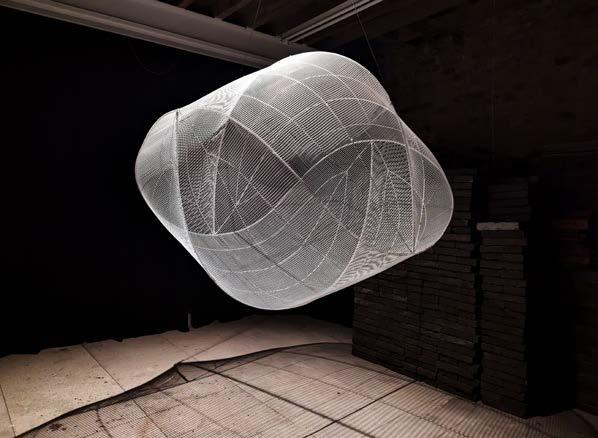
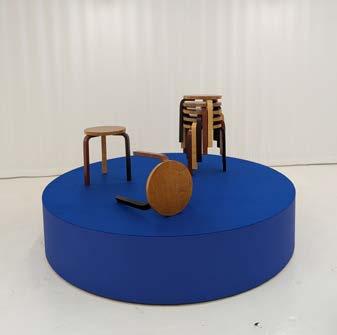




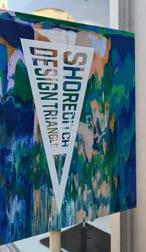
created by Daniel Eatock in collaboration
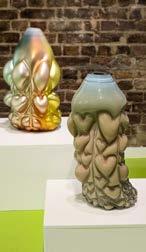
CAN SIT WITH US TOO HANSDOTTER
Love- Print (soft rainbow metallic and metallic), 2023

YOU CAN SIT WITH US TOO SELFISH CUSTOMS
Synthetic Hair on Canvas

ROLLING PIN PAINTING ON PLYWOOD
Daniel Eatock

SOWDEN CLUB ARMCHAIR
George Sowden
SCP


GUMMY CHAIR

THE COMFORTABLE TRUTH
Oscar Coakley


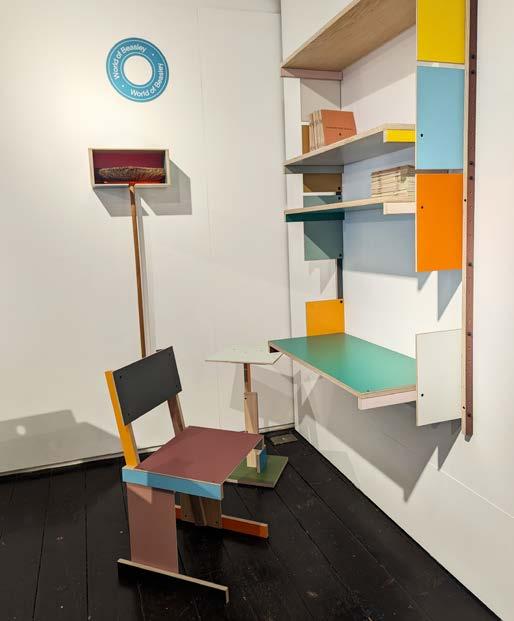

Anagram Sofa System
Panter&Tourron
‘Anagram lives up to its name: you can continually rearrange the individual components to create different stories and situations.’ Panter&Tourron

AI Concept Device - Shown at Design You Can Feel Future Facility, London
‘For handheld mobile devices, we find ourselves element is no longer camera resolution, OLED communicate using artificial intelligence (AI). SUSA of interface that simplifies interactions.’ Future


Feel by Dezeen and ASUS
ourselves at a new juncture, where the most powerful display, or memory capacity, but the ability to SUSA experiments with a more primitive form Future Facility,
Clore Lounge Chair with Central Stool
‘Tamart is a new British design brand honouring the work and love story of the modernist architects and polymaths, Tamar de Shalit and Arthur Goldreich. By reimagining and contemporising mid-century pieces, Tamart becomes an expression of their synergistic and multi-disciplinary achievements.’ Tamart
Guests were welcomed with a delicious pastry breakfast as the room filled to capacity, reflecting the strong interest in this timely conversation. The event brought together leading voices from the design industry to explore the balance between traditional influences and cutting-edge innovation, and how these elements shape the future of design.
The discussion was chaired by Alys Bryan, Editorial & Marketing Director of Design Insider, and featured a distinguished panel of experts: Adam Fairweather, Founder of Smile Plastics; Bella Bertoni, Associate at FEL; Ian Weddell, Sustainability Executive at USM; Lee Roberts, Creative Director at Zebra Projects; and Jodie Hatton, Design Manager Europe at Brintons.
The panel explored the dynamic crossroads of heritage and futurism in design, examining how historical design principles continue to influence contemporary practice while embracing the evolving potential of emerging trends and technologies. The speakers delved into the delicate balance of preserving traditional craftsmanship and integrating innovative methods, sharing insights on how the past, present, and future collectively shape the design landscape. The conversation highlighted the industry’s ongoing challenge of honoring legacy while pushing the boundaries of what is possible, ultimately offering attendees a richer understanding of how to navigate this ever-changing field.
Hear we take a look at key points raised within the discussion:
Lee Roberts
Lee Roberts emphasised the importance of representing heritage through branding while adapting to multi-generational markets and evolving retail spaces. He highlighted that a contemporary business model is essential to support heritage branding, ensuring it remains relevant. Lee discussed how integrating traditional design values with innovative strategies helps brands connect with both legacy customers and new generations, ultimately sustaining a brand’s influence in a competitive market.

Jodie Hatton
Jodie Hatton discussed Brintons’ approach of referencing to create sustainable products, emphasising By drawing on their rich archives, Brintons adds designs. Jodie stressed that this approach allows designs that tell a genuine story while supporting
Adam Fairweather
Adam Fairweather discussed Smile Plastics’ journey how the company has continuously reviewed processes to reduce energy waste and enhance craftsmanship and “visual identity” of their merges heritage with innovation by transforming pieces that balance quality, sustainability, and
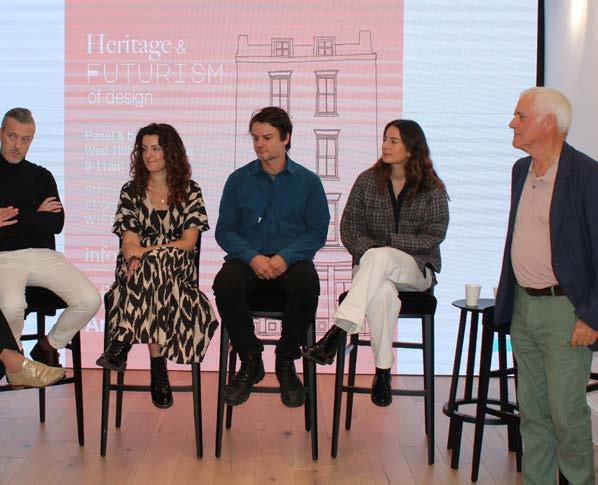
Bella Bertoni
referencing historic manufacturing processes how heritage informs contemporary design. adds depth and authenticity to their carpet allows them to resonate with clients, offering supporting environmentally conscious production.
journey since their launch in 2015, highlighting reviewed and reinvented its manufacturing enhance sustainability. He emphasised the unique their products, showcasing how Smile Plastics transforming recycled materials into decorative and contemporary design.
Bella Bertoni discussed FEL’s thorough research process and how its insights shape the studio’s direction. She explained how FEL blends technological innovation with the intelligence of nature to inform their design approach. Highlighting recent projects, Bella demonstrated how this research-driven methodology aims to positively impact both the environment and the community.
Ian Weddell
Ian Weddell discussed USM’s iconic design heritage, particularly the Haller system, which remains central to the brand’s identity. He emphasised that while heritage is crucial, it must be supported by a forward-thinking business model. Weddell highlighted USM’s commitment to sustainable design, integrating modern technology like their new app that scans furniture, reinforcing the need for adaptability and a contemporary approach to complement their timeless, modular products.
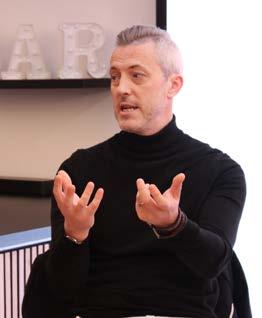
1. LEE ROBERTS
CREATIVE DIRECTOR
ZEBRA PROJECTS INC
Lee Roberts, the maestro behind our awe-inspiring spaces for over two decades, serves as the Creative Director, stationed in London. With an unwavering focus on creativity, Lee orchestrates the design journey from concept to implementation, infusing each project with determined enthusiasm and reimagined possibilities.
4. BELLA BERTONI ASSOCIATE FOR EVERYDAY LIFE
For Everyday.Life believe in the transformative power of design to enrich everyday life. Their team of architects and designers is focused on creating solutions that are both functional and beautiful and, at the same time, shifting the dialogue on conventional thinking.
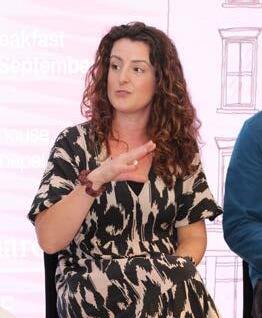
2. JODIE HATTON DESIGN MANAGER EUROPE BRINTONS
Jodie is a textile designer with over 10 years experience in bespoke design with a focus on high-end interior projects. She is the Design Manager at Brintons, purveyors of designer carpets, and she is currently working towards completing a masters in design research focussing on sustainable and regenerative design solutions.
5. IAN WEDDELL SUSTAINABILITY EXECUTIVE
USM MODULAR FURNITURE
Design, Flexibility, Quality and Durability: These words symbolise the character and ethos of USM’s unique Modular Furniture System. A system designed for infinite reuse and reconfiguration. A system that increases the life of the material and improves the furniture’s environmental impact over time.
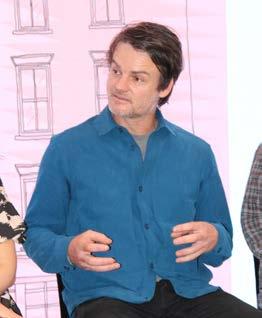
ADAM FAIRWEATHER FOUNDER
In 2015, the existing dormant Smile Plastics brand was revived by Adam Fairweather and Co-Founder Rosalie McMillan, specialising in materials design and closed-loop recycling models. Based in South Wales, Smile Plastics focuses on manufacturing large-scale decorative panels made entirely from 100% recycled and recyclable plastics.
MODERATOR: ALYS BRYAN
EDITORIAL & MARKETING DIRECTOR
DESIGN INSIDER & COMMERCIAL INTERIORS UK
Alys is focused on instigating conversations, both online and in-person, with industry experts which challenge, educate and advance the commercial interior sector. Her training and 20 years of professional experience as a furniture designer for the commercial sector makes her uniquely placed to lead Design Insider as Editorial Director.
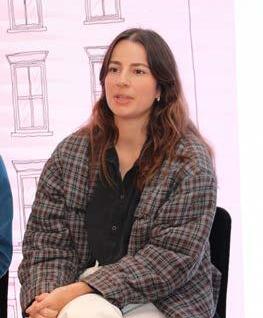
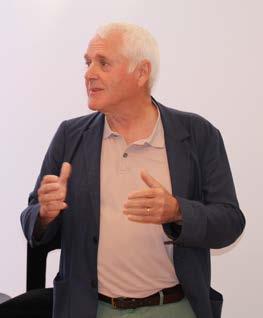
MATERIAL MATTERS RETURNED TO BARGEHOUSE, OXO TOWER WHARF, AS A STANDOUT EVENT OF LONDON DESIGN FESTIVAL 2024, EXPERTLY ORGANISED BY GRANT GIBSON AND WILLIAM KNIGHT.
THE FAIR BROUGHT TOGETHER WORLD-LEADING BRANDS, DESIGNERS, MAKERS, AND INNOVATORS TO REALLY EXPLORE AND CELEBRATE THE TRANSFORMATIVE POWER OF MATERIALS. AS THE ONLY EVENT OF ITS KIND FOLLOWING THE LOSS OF 100% DESIGN, DESIGN JUNCTION, AND LONDON DESIGN FAIR, MATERIAL MATTERS HAS SOLIDIFIED ITS PLACE AS THE GO-TO GROUP PLATFORM AND FOR HIGH QUALITY MATERIAL EXPLORATION.
From the moment you step through the doors, the atmosphere is electric—bustling with excitement and brimming with exhibits that push materiality forward. Sustainability was a key theme, seamlessly woven into the fabric of the show’s material innovations and forward-thinking concepts, demonstrating the crucial role of materials in shaping a sustainable future.
Among our highlights was Fibre Futures, an exhibition by BIOTEXFUTURE funded by the German Federal Ministry of Education and Research, with leadership from adidas AG and RWTH Aachen University. The installation showcased groundbreaking bio-based textile research, offering insights into innovative spinning techniques, alternative resource streams, and bio-manufacturing processes that promise to revolutionise the textile value chain. Fancy a running jacket produced from the outermost layer of a cows gut?
Another standout was the TP Bennett in partnership with The Furniture Practice, exploring the furniture industry’s relationship with the circular economy. Located in Room 12, the exhibit featured detailed explorations of components,
materials, and manufacturing processes behind products from twelve leading commercial interior brands. The room also served as a dynamic space for networking, featuring a café bar by Smile Plastics and a storytelling area hosting workshops and demonstrations throughout the fair. This was LDFs primary platform for commercial suppliers, something which could certainly be expanded upon.
Key brands in Room 12 on display included Camira, SAS, Modus, Arper, Fredericia, Normann Copenhagen, and Humanscale. Notably, the show marked the UK debut of Barcelona-based Suru and Australian company REDDIE, alongside Cornwall-based MARK Products, which particularly impressed with their conversations with their production team.
Material Matters provided a vibrant platform for commercial suppliers to showcase their expertise, passion, and sustainable innovations, reinforcing the critical role of materials in contemporary design. It was a true joy to witness the materiality and ingenuity that defined this year’s fair.
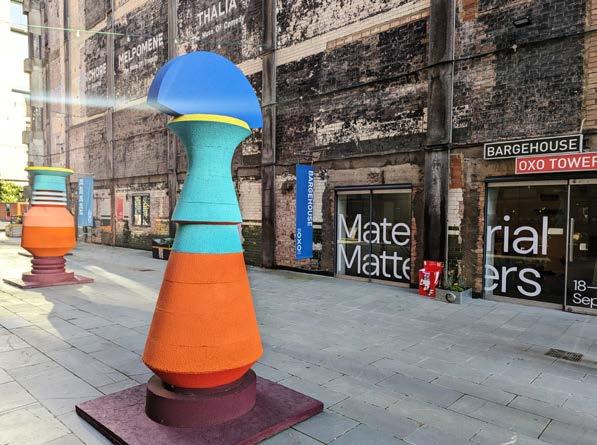



Hydro’s inspiring installation captivated attendees by showcasing their complex aluminium extrusions in both lengths and cross-sections. Hydro introduced the 100R project, which challenged seven internationally renowned designers—including Inga Sempé, Max Lamb, Andreas Engesvik, Shane Schneck, Rachel Griffin, John Tree (shown above), and Philippe Malouin—to create products from Hydro CIRCAL 100R, the world’s first aluminium made entirely from recycled post-consumer scrap on an industrial scale.
A delightful surprise was Locally Grown by
visitors to explore hair as an innovative material with of the Kingdom of the Netherlands and co-curated a working hairdresser, offering live haircuts that elevated experienced the journey from fibre to product through a showcase of design objects. Collaborating with unique objects incorporating hair yarn, cord, and rope, and circular design.

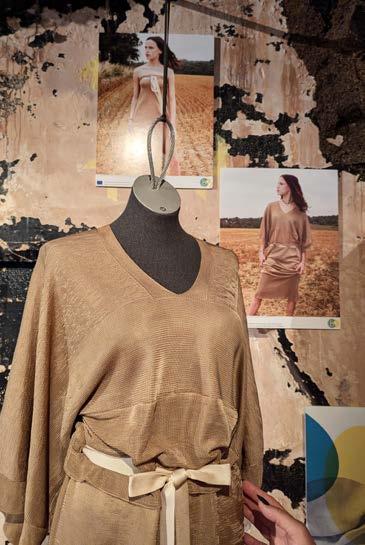
Sanne Visser, an interactive installation that invited with untapped potential. Supported by the Embassy co-curated with Company, Place, the installation featured elevated participation to an entirely new level. We through spinning, rope-making demonstrations, and several designers, Studio Sanne Visser presented rope, demonstrating the possibilities of regenerative
Occupying a space in the very far corner of the talks space, Herewear showcased a range of the final results from their project. Herewear is a 4-year EU-funded project with a holistic, systemic approach towards the creation of locally-produced circular materials made from bio-based agriwaste - Wheat straw. Innovative new processes built on the latest bio-based polyesters and cellulose developments, all piloted at semi-industrial scale.


GOLD
bacterial cellulose
Malai is a newly developed material made from entirely organic and sustainable bacterial cellulose, grown on agricultural waste sourced from the coconut industry in Southern India.
Malai work with the local farmers and processing units, collecting their waste coconut water (which would otherwise be dumped, causing damage to the soil) and re-purposing it to feed the bacteria’s cellulose production. One small coconut-processing unit can collect 4000 litres of water per day, which we can use to grow 25kg of cellulose.
Malai is a flexible, durable material comparable to leather or paper.
Bio-textiles for sustainability. Partner - Mimotype Technologies
In collaboration with biotech startup Mimotype, GOLD led the development of a regenerative outdoor textile demonstrator using collagen, focusing on design for circularity and innovation.
With 65% of textiles currently made from synthetics, GOLD’s work addresses the urgent need for sustainable alternatives as synthetic fiber production and CO2 emissions continue to rise. Drawing inspiration from historic uses of collagen, such as Inuit waterproof parkas, GOLD explored advanced fabrication techniques, including robotic yarn laying and material lamination. This project showcases collagen’s potential as a biodegradable, recyclable material that could reshape the textile industry, creating a sustainable, circular biosynthetic value chain for future generations.
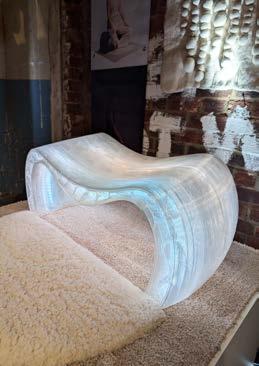
Sofia Hagen x Studio Marmi
Sofia Hagen x Studio Marmi bring together the latest in innovative 3D printing technologies and artisanal craftsmanship to create a timeless design dedicated to mindfulness.
HEMPLA is a meditation furniture set that creates a sanctuary to relax and meditate in a variety of configurations. HEMPLA consists of a handmade hemp and wool rug, and a selection of seats: HEMPLA I in 3D printed hemp and sugar - and HEMPLA II in 3D printed sugar and integrated lighting by Studio Waldemeyer, programmed in line with the user’s circadian rhythm. HEMPLA seamlessly blends digital and traditional artistry while symbolising interconnectedness with nature and is structured around the Zen garden principles: simplicity, harmony, tranquility.

Catifa 53, designed in 2001 and Arper’s first product with an environmental product declaration, enters a new era through a partnership in material innovation.
Catifa Carta features a re-engineered shell made of PaperShell, a revolutionary new material made of composite wood by-product, which provides the strength and comfort essential to Catifa’s now iconic, bicurved silhouette. A first of its kind innovation, PaperShell dramatically reduces Catifa Carta’s impact on the environment by doing what trees do: sequestering carbon dioxide. At the end of its life cycle, the material can be reduced to biochar, successfully retaining the CO2 sequestered during the previous life phases.






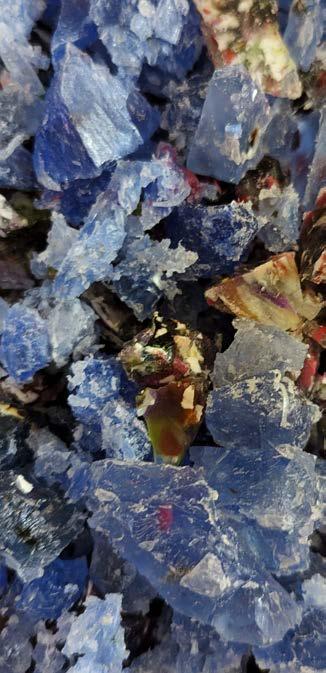
M MOSER
M MOSER UNVEILED “RESONANCE,” AN IMMERSIVE AUDIOVISUAL INSTALLATION THAT EXPLORED THE DIVERSE WAYS OUR BRAINS RESPOND TO ENVIRONMENTAL STIMULI. PRESENTED AT THE STUNNING OLD SESSIONS HOUSE, THIS INNOVATIVE EXPERIENCE COMBINED WEARABLE TECH WITH GENERATIVE ART, ALLOWING VISITORS TO CREATE UNIQUE ARTWORKS BASED ON THEIR BRAIN ACTIVITY.
Using an EEG headband, each participant’s brainwaves were transformed into personalised visual art, accompanied by a corresponding soundtrack. These unique thought signatures were projected into the room, creating an immersive environment of light and sound. Despite our best efforts, the excitement of the installation—and the energy of LDF itself—meant we couldn’t achieve calm, green waves; instead, our brain activity generated active red waves throughout the experience. Each recording was added to an online archive, showcasing the individuality of every user’s experience.
The installation, brought to life by M Moser’s design team, including Jessica Adkins, Alex Kendrick, and Frances Gain, highlighted the firm’s commitment to neuro-inclusive design. In partnership with Knotel, the project celebrated neurodiversity, offering visitors a visual exploration of how we all perceive the world in different ways.


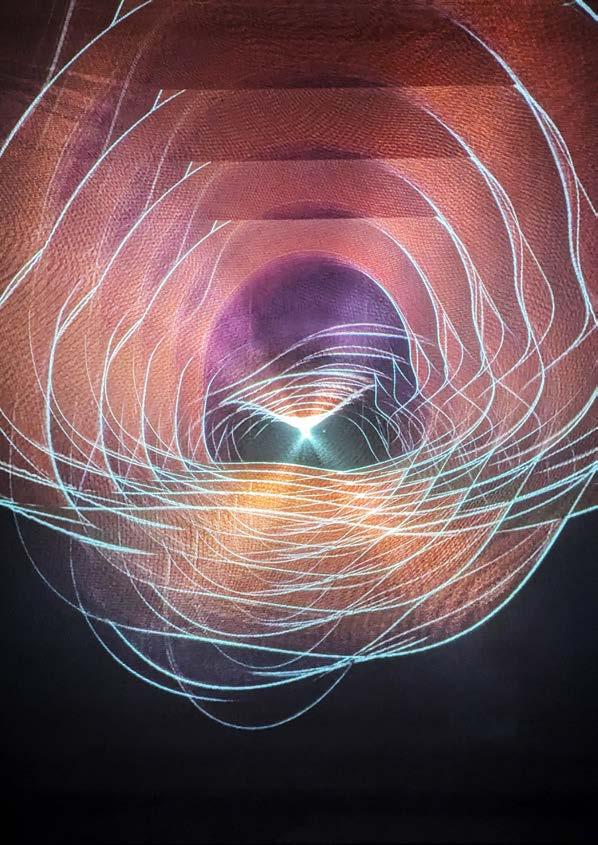
INVITED BY &TRADITION, WE ATTENDED AN UNFORGETTABLE EVENING ON THE 6TH FLOOR OF THE ROYAL FESTIVAL HALL FOR THE RELAUNCH OF ROBIN DAY’S ICONIC FURNITURE PIECES. THE LIGHT-DRENCHED SPACE, WITH VIEWS OF THE LONDON EYE AND BIG BEN, SET A PERFECT BACKDROP FOR THE EVENT.
WE ADMIRED INSTALLATIONS THAT JUXTAPOSED ROBIN DAY’S FURNITURE AGAINST LUCIENNE DAY’S TEXTILE DESIGNS—PERFECTLY EMBODYING THEIR SHARED LEGACY.
&Tradition unveiled two key collections from Robin Day’s career: the RFH Collection, featuring pieces designed for the Royal Festival Hall, and the Daystack Collection (originally the Hillestak collection from the 1950s), bringing modern design to life once more with a touch of Danish craftsmanship.
Paula Day, Robin and Lucienne Day’s daughter, opened the discussion with a moving reflection on her father’s career, from his early days as a draftsman to his partnership with Hille, where his visionary designs shaped British modernist furniture. She spoke of his pioneering work in the MoMA International Low-Cost Furniture Competition, which launched his career .
When asked by Johanna Agerman Ross, Chief Curator at the Design Museum, Paula shared how her father and mother, Lucienne Day, worked in parallel, each 'feeding each other's ambition'. She fondly recalled the synergy between her mother’s textiles, like the famous Calyx design, and her father’s three-dimensional forms, epitomised by the Daystack series.
Paula described how Robin’s success at the Festival of Britain led to his commission to design all of the seating for the Royal Festival Hall, a monumental project. She noted how his designs expressed

hope and optimism, qualities that align with &Tradition’s ethos.
Els Van Hoorebeeck, Creative Director at &Tradition, elaborated on their partnership with the Robin & Lucienne Day Foundation, explaining why a Danish brand would choose to relaunch these iconic British designs. The answer lay in the timeless quality and purpose of Robin Day’s work—pieces that could transcend the “treadmill of newness” and find relevance in today’s market.
The Daystack and RFH collections have been meticulously updated for contemporary settings, with rescaling and subtle adjustments to ensure durability and functionality. Debika Ray, Editor of Crafts Magazine, placed the craft of Robin Day’s designs in a broader context, emphasising that craftsmanship and production, whether hand or machine-led, coexist harmoniously in design.
Paula closed with touching anecdotes, recalling how her father designed through making, often sketching ideas on the edge of the Radio Times and prototyping them the next day.
The evening was a poignant tribute to Robin Day’s legacy, reminding us of the playful, optimistic spirit that continues to live on through these timeless designs.

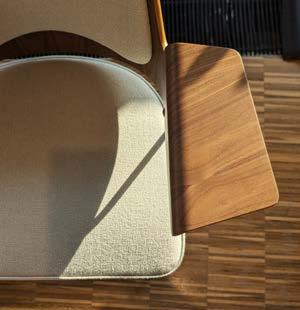

AS THE FIRST OFFICIAL EVENT DISTRICT OF LONDON DESIGN FESTIVAL, BROMPTON DESIGN DISTRICT HAS LONG ESTABLISHED ITSELF AS A LEADING HUB FOR DESIGN EXPLORATION. IN ITS ANNUAL PARTNERSHIP WITH JANE WITHERS STUDIO, A KEY VOICE IN DESIGN CURATION, THE DISTRICT CONTINUES TO PUSH BOUNDARIES. JANE WITHERS, AN ESTEEMED DESIGN CONSULTANT, CURATOR, AND WRITER, BRINGS HER STUDIO’S MULTIDISCIPLINARY EXPERTISE IN STRATEGY, CONCEPT DEVELOPMENT, AND CURATION TO BROMPTON’S PROGRAMMING, ADDRESSING CULTURAL AND SOCIETAL CHALLENGES THROUGH INNOVATIVE DESIGN THINKING.
This year’s theme, The Practice of Learning, invited designers and collectives with a learning-centric approach to delve into knowledge exchange, experimentation, and creative development. The district expertly wove this theme throughout, creating a rich environment of discovery.
Ria Hawthorn, Project Director at Jane Withers Studio explained:
‘Learning is an essential part of the design process, whether developing an understanding of materials and production, or through iteration and experimentation, or through collaboration. It’s also an aspect of design that is often overlooked, and in today’s world when resilience and agility are important both for a successful design practice and in solving human-made problems, it was something we wanted to focus on. We invited designers and collectives with a collaborative approach to respond to our theme and programmed them for their different approaches - from established design galleries to emerging design talents. We also wanted to foster learning in practice during the festival and encouraged the develop programming for their spaces. Both Andu & Mikey’s Making Room and POoR Collective embraced this with a rich programme of hands-on workshops as well as talks and conversations around design practice, heritage, and
collaboration, brought different people together and enabled exchange across disciplines. It was wonderful to see Making Room’s space flourish with the results of workshops - from stools and vases, to shelves and lamps - all used in the space as the festival progressed. There was a spirit of collaboration and generosity across the programme that I’d like to see continue.’
Key highlights of this year’s district, covered in the following pages, include Grymsdyke Farm, Poor Collective, and Andu, each showcasing learning as an integral part of their design process.
Further standout exhibitions included ‘Through Process to Progress’ by renowned Polish designer Oskar Zięta at Loop Generation, where his air-sculpted metal creations offered a glimpse into a continuous design journey. We were also captivated by Curious Habits – Design as Learning, presented by MA Design Products students from the Royal College of Art. Notably, graduate Anees Mehkri showcased Air Loom, a low-tech air filtration system using natural fibers like banana silk and coir, aimed at improving workshop conditions in India.
1. Grymsdyke Farm
2. Brompton Design District, Jane Withers Studio
3. Oskar Ziętaat Loop Generation
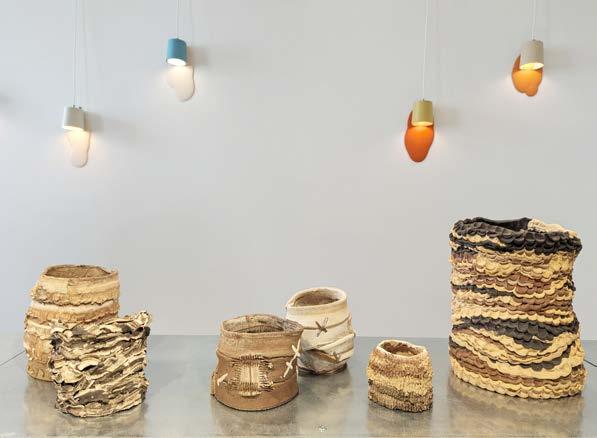

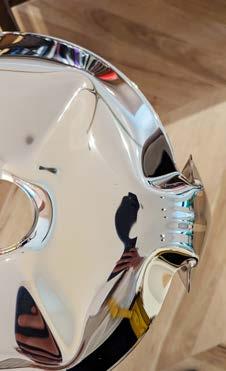

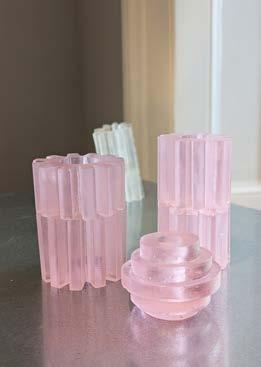
Following the success of last year’s The Farm Shop, Grymsdyke Farm returned to Brompton Design District with an exciting new collaborative exhibition. Reading Design showcased the outcomes of workshops led by four designer-educators:
Attua Aparicio, Marco Campardo, Studio Glithero, and Guan Lee. The project explored the process of learning through design, emphasising how individuals can learn from each other, the environment, and through hands-on making. This exhibition continued Grymsdyke Farm’s tradition of fostering collaboration and experimentation within the design community.
Guan Lee, the founder of Grymsdyke Farm, hosted a series of workshops as part of a four-week program, where students spent each week exploring a different material and process. All workshops took place at Grymsdyke Farm, a former working farm in Buckinghamshire. Lee, an architect and professor at the Bartlett School of Architecture, established the facility in 2004 as part of his PhD research, which has since evolved into a hub for material experimentation. For this program, Lee guided students through the process of shell casting, which they used to create wire-like bronze chairs and tables. (Above left)
Attua Aparicio, a Spanish artist and ceramics specialist, led a workshop focused on clay. Students explored techniques for combining different colours of clay, with the resulting vessels featuring visible finger and tool markings, as well as distinct joints that told the story of their creation. Techniques such as extrusions, pinching, and stitching allowed participants to experiment with layering and craftsmanship in clay work. (Right)
Marco Campardo, an Italian designer, hosted a workshop on innovative ways of using wax for glass casting. Students produced vases that showcased a variety of forms, textures, and levels of transparency. The pieces ranged from pink and blue tones to spiraling and tubular shapes, highlighting the versatility of glass and wax in design. (Above right)
The workshop led by Sarah Van Gameren, co-founder of Dutch design studio Glithero, explored how spilt material can offer a unique aesthetic. By embracing accidents in material handling, students discovered new ways to transform mishaps into intentional design elements.
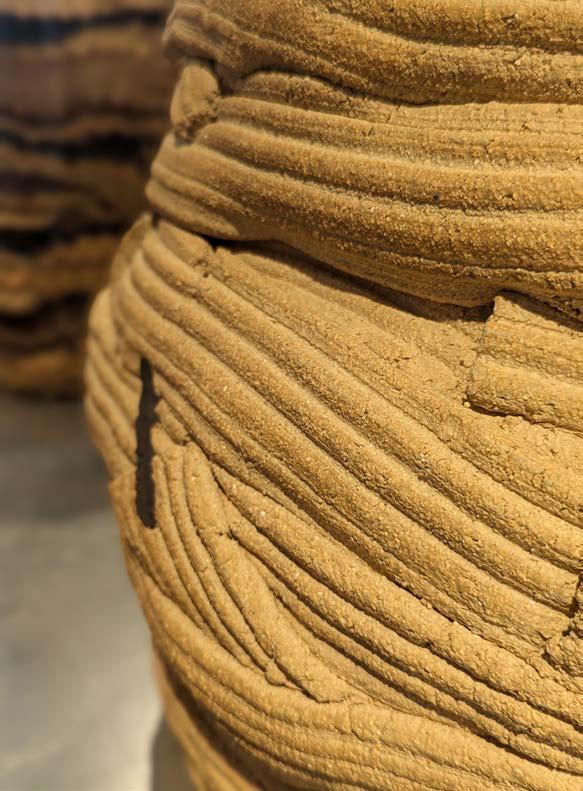

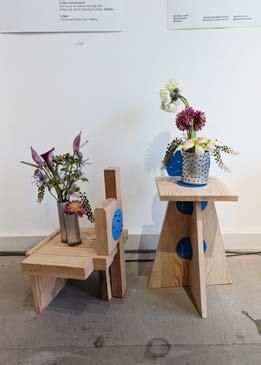

A standout highlight of Brompton Design District was The Making Room, a dynamic workshop space hosted by designers Andu Masebo and Mikey Krzyzanowski. The space invited visitors to come together, absorb knowledge from a range of sources, and learn through hands-on experience. Each day, a series of workshops, talks, and happenings unfolded, fostering collaboration and encouraging new ways of thinking. As the festival progressed, the space itself evolved, gradually becoming populated by the creative outputs of its participants.
The inclusive workshops featured a diverse group of collaborators, including Helen Job of Observatory Studio, Stacie Woolsey, founder of Make Your Own Masters, Mitre & Mondays, Bafic, Christian Cassiel & Ayo Fagbemi of Seed Archives x Explorers Club, and Nelly Benhayoun. Together, they cultivated a welcoming environment where collaboration was integrated into the very fabric of the design process.
The unique aspect of The Making Room was that the items furnishing the workspace were created throughout the event. Attendees worked together to build furniture, embodying the collaborative ethos of the space. Each participant was encouraged to take part in the design and making process, resulting in tangible creations they could take home at the festival’s end. These physical items, combined with a “library” filled with books and crafted pieces, enriched the space, making it feel both active and inviting.
A particularly thoughtful detail was the design of the visible brackets used throughout the project, intentionally simple to remove barriers to learning about complex joints, ensuring the space remained accessible to all skill levels.
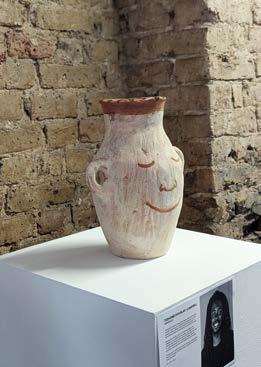
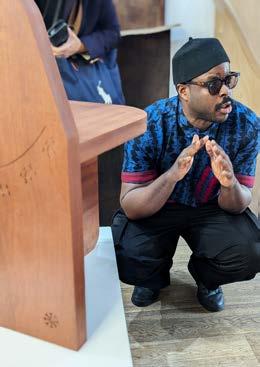
POoR Collective made a powerful return to Brompton Design District with POWERSHIIFT 2024, an exhibition that aligned perfectly with this year’s curatorial theme, The Practice of Learning. The initiative invited designers to create pieces from design disciplines new to them, encouraging them to learn how to utilise their creative skills in unfamiliar areas. Drawing on their cultures, surroundings, and lived experiences for inspiration. The exhibition provided a much-needed platform for those who might otherwise struggle to showcase their work during the prestigious design week.
POoR—short for Power Out of Restriction—is rooted in the idea of empowering young people by giving them opportunities to influence their environment through small-scale architecture and design projects. This year’s exhibition focused on creatives transitioning from one discipline to another, reflecting the fluidity of design thinking and innovation.
Among the standout pieces was Shanti Bell, a fashion designer who developed a series of benches with moulded plywood seats, evoking the shapes of fabrics wrapped around the body (right).
Bisila Noha, an international relations graduate, explored movement in clay through her vessel design, while Richard Adetokunbo Aina crafted chairs inspired by the regal seats of Ethiopia’s Gurage people, referencing traditional African craftsmanship. Myles Igwebuike’s Njiko Stool incorporated intricate geometric patterns informed by Igbo mythology from Nigeria (above right).
The exhibition also featured architectural designer Teshome Douglas-Campbell, who displayed a clay vase adorned with a smiling face (above left), representing a “vessel for happiness,” alongside a painting that reflected his exploration of new materials and forms. Together, these designers exemplified the spirit of POWERSHIIFT—encouraging young creatives to expand their horizons and impact their communities through design.
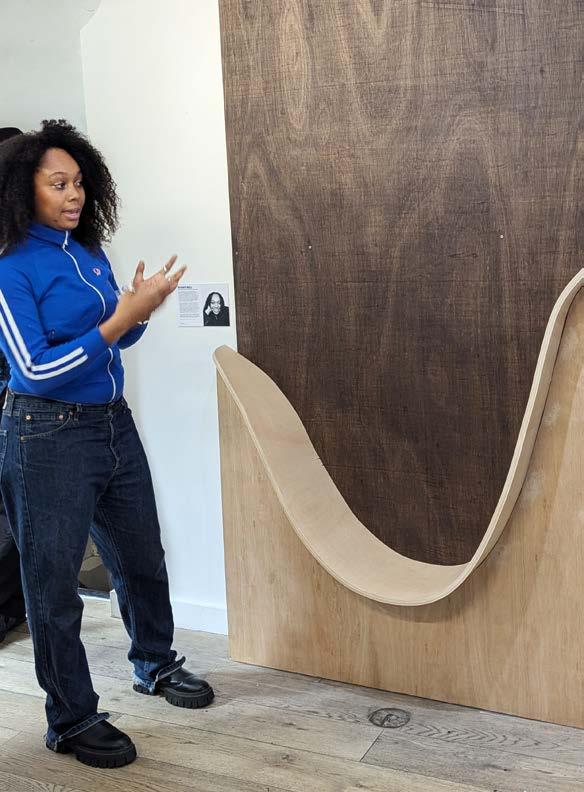

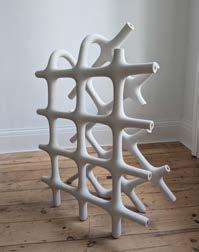

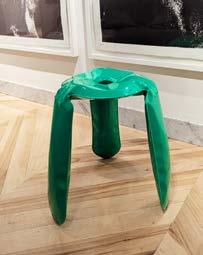


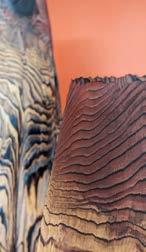
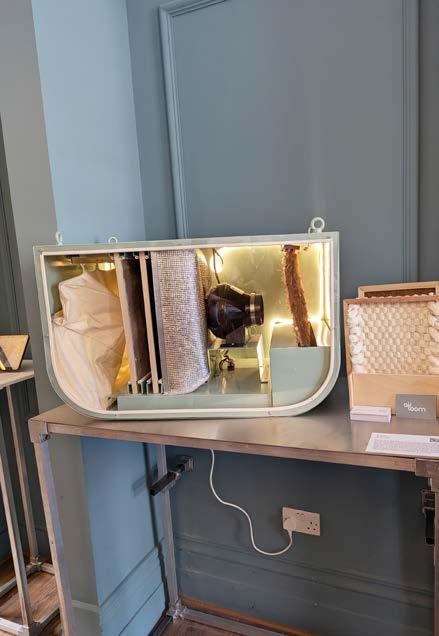
AMONG THE MANY IMMERSIVE EXPERIENCES AT LONDON DESIGN FESTIVAL 2024, ONE INSTALLATION STOOD OUT FOR ITS EMOTIONAL DEPTH: JUICY BOOTH BY ARTIST ANNIE FROST NICHOLSON AT COAL DROPS YARD. THIS VIVID KIOSK INVITED VISITORS TO CONFRONT ONE OF THE MOST COMPLEX HUMAN EMOTIONS—SHAME— AND OFFERED A TRANSFORMATIVE, MULTI-SENSORY REFUGE IN THE PROCESS.
Presented in collaboration with K67 Berlin and The Loss Project, Juicy Booth provided ten-minute confessional sessions that encouraged participants to unburden themselves in a safe, vibrant space. Inside the booth, an 80s-style keyboard allowed visitors to type out their confessions, which were displayed on LED monitors. The space responded to these emotional revelations with light, sound, and colour— every confession was mapped to emotional coordinates, triggering operatic soundscapes and corresponding hues. The experience invited visitors to let go of their shame, leaving the booth feeling lighter, brighter, and more at peace.
The carefully designed booth integrated colour, music, and light to create a deeply personal journey for each visitor. The emotionally charged confessions were elevated into an artistic mapping of human vulnerability, underscoring the healing power of self-expression. Nicholson’s
work continues to push boundaries, offering a unique method for confronting inner struggles in a public space.
Nicholson, formerly known as Kid Fandango, has a long history of using art to smash taboos around mental health and grief. Her previous projects include The Fandango Discoteca, a touring disco focused on mental health and collective grief, and Fandango Whip, an ice cream van designed for post-pandemic grief and healing.
In collaboration with The Loss Project, which connects communities through universal experiences of grief, and K67 Berlin, known for restoring historical booths into creative spaces, Juicy Booth was more than just an installation—it was a space for emotional release, where visitors could shed their burdens and experience true catharsis.
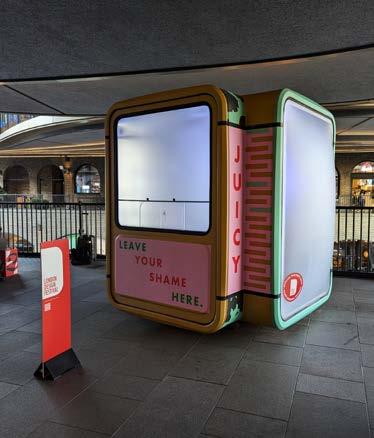


WHILE NOT AS ESTABLISHED AS BROMPTON, MAYFAIR DESIGN DISTRICT MADE A SIGNIFICANT IMPACT AT LONDON DESIGN FESTIVAL 2024, FEATURING STANDOUT INSTALLATIONS SUCH AS THE LDF LANDMARK PROJECT LIQUID LIGHT AND FORAGED BY HEITER X AT SOSHIRO, ONE OF OUR FESTIVAL HIGHLIGHTS.
The Liquid Light installation, created by the celebrated artist collective Marshmallow Laser Feast in collaboration with Johnnie Walker, set out to offer a mesmerising immersive experience combining light, sound, and glassmaking craftsmanship. Its central feature was a series of suspended glass-blown droplets meant to symbolise the balance between strength and fragility. While its ambitions were high, the installation ultimately fell short of its full potential, requiring repair during our visit. Nonetheless, Liquid Light was an intriguing project that reflected Johnnie Walker’s commitment to pushing creative boundaries.
Mayfair also offered the opportunity to watch portrait artist Mercedes Carbonell at work, which we thoroughly enjoyed. This live demonstration was part of Porcelanosa’s extensive festival programme, which also included decorative tile workshops.
Another highlight of the district was the opportunity to explore the interior of ROOM by world-renowned artist Anthony Gormley at The Beaumont Mayfair. Normally, only the exterior is available for viewing, but during LDF 2024, guests were given rare access to tour the interior of this celebrated space.
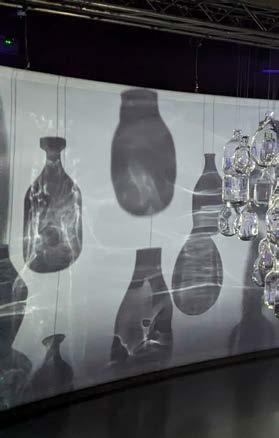
2. The Beaumont, ROOM by Antony Gormley
3. Portrait artist Mercedes Carbonell, Porcelanosa
4. Porcelanosa, Earthcrafted Designs
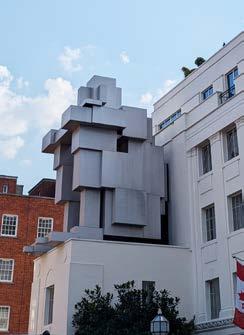
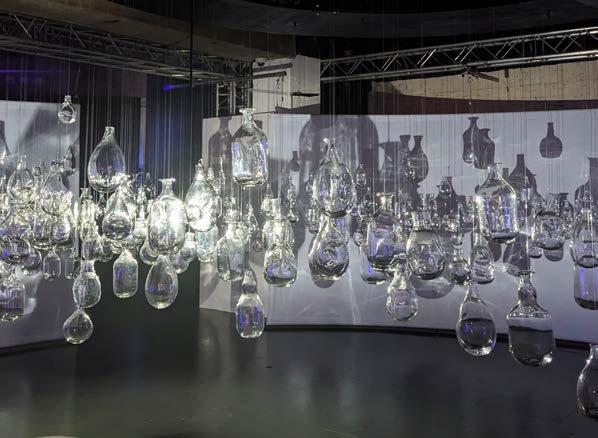
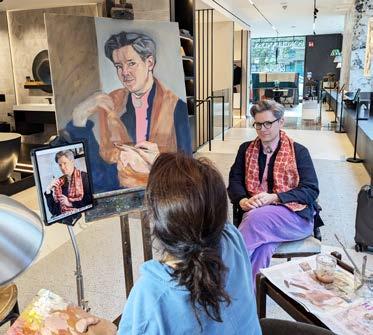
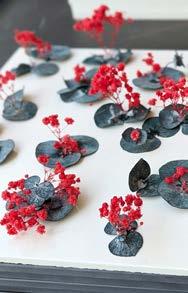

Heiter X presented Foraged, an immersive exhibition that blurred the lines between food, design, and nature. Known for curating exhibitions and collaborations with chefs, foragers, and designers, Heiter X crafted a holistic experience that invited guests to engage with food in an entirely new way. Every detail within the space contributed to the immersive atmosphere, creating a seamless blend of design and culinary creativity.
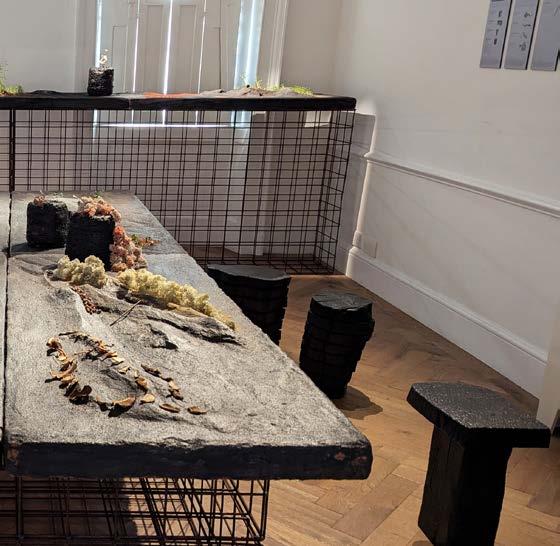
One of the standout features of the exhibition was the clay display tables, which incorporated a Terra Firma installation—food growing directly on the tables themselves. This pushed the concept of “farm to table” to a new level, eliminating any processing and highlighting food in its purest form. Here, the food was the star, freed from the confines of traditional plates, allowing guests to experience it in an entirely unmediated way.
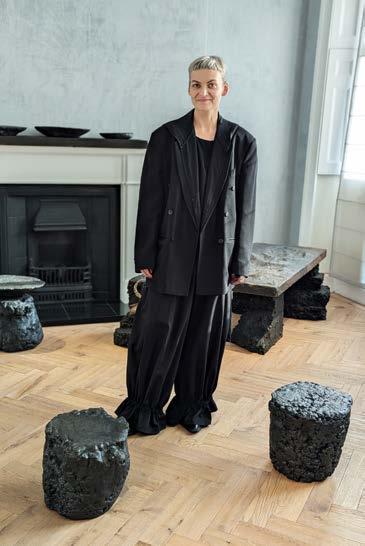
Hearing Heiter X speak in person was both fascinating and engaging, as her passion for her work shone through. With a background in landscape architecture and food design,
Heiter X is an artist-designer who reimagines the relationship between food, people, and the environment. Her work is rooted in sustainability, creating immersive experiences that challenge the boundaries of traditional food presentation and consumption.
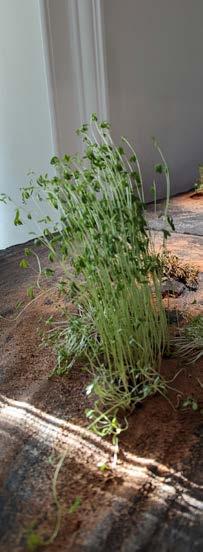
Heiter X’s connection to foraging began in her her grandparents how to gather seasonal ingredients This deep connection to nature was a core displayed alongside artworks created by Heiter Robin Berrewaerts.
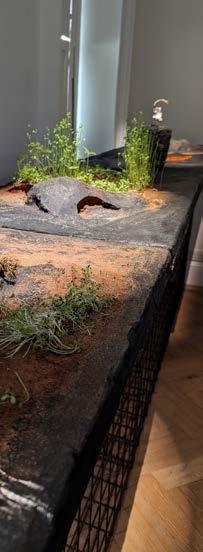
CONNECTION TO NATURE
childhood in Estonia, where she learned from ingredients and preserve them with salt or sugar. theme of the exhibition, with foraged items Heiter X’s collaborators, including Erk Merisalu and

Heiter X collaborated with two talented chefs, Daanius Aas and Tiiu Aruoja, to meticulously prepare the foraged ingredients. The dishes featured preserves and natural flavorings that highlighted the unique qualities of the ingredients. Among the items we tasted were infused reindeer moss and fermented sweet pine cones—delicacies that reflected the careful balance of nature and flavour, transforming the foraged into something extraordinary.
83 RIVINGTON STREET WAS TRANSFORMED INTO A VIBRANT CREATIVE HUB FOR THE PROOF OF CONCEPT EXHIBITION, A STANDOUT FEATURE OF THE SHOREDITCH DESIGN TRIANGLE DURING LONDON DESIGN FESTIVAL 2024. SHOWCASING THE WORK OF TEN MULTIDISCIPLINARY DESIGNERS AND STUDIOS, THE EXHIBITION PROVIDED A UNIQUE INSIGHT INTO THE JOURNEY FROM CONCEPT TO REALISATION. VISITORS EXPERIENCED A RARE GLIMPSE INTO THE DESIGN PROCESS, WITH FINAL WORKS DISPLAYED ALONGSIDE PROTOTYPES, SKETCHES, AND MODELS, ILLUSTRATING THE EVOLUTION OF EACH PIECE.
Held in Arches 2 and 3, the exhibition spanned a wide range of disciplines, including furniture, ceramics, glass, textiles, and architecture. By revealing the challenges of bringing innovative ideas to life, such as limited funding or the need for support from larger brands, Proof of Concept celebrated the creativity, craftsmanship, and perseverance involved in each project
One of the standout highlights was David Irwin’s Knockdown Sling Chair, which exemplified sustainable design. Created in collaboration with Camira Fabrics, the chair features a 95% recycled polyester sling, including SEAQUAL® yarn made from ocean plastic, and is crafted using a zero-waste knitting process. This design emphasises Irwin’s dedication to sustainability and thoughtful material use.
Other notable contributions included Mentsen’s modular shelving system, made from solid ash and aluminium, and Aimee Betts’ Ricasso Zig Zag Pull Handle, a textile-led design combining Biothane lace with precision-cut aluminium. Atelier Thirty Four showcased their 1909 Lounge Chair, crafted within four miles of the exhibition venue and reflecting a commitment to local production and sustainability.
The exhibition also featured Emma Louise Payne and Phoebe Stubbs’ “Meld” collection, which merged ceramics and glass into striking lighting pieces, Daniel Schofield’s Stopper Lamp, and John Tree’s Quattro Chair for VG&P, highlighting the creativity and innovation behind each concept
Adding to the dynamic environment, the Deadgood x Cook House pop-up restaurant offered a fresh, casual dining experience curated by chef and architect Anna Hedworth, while Mitre & Mondays’ Café Tolerance and Origin’s outdoor furniture installations provided interactive spaces for visitors to engage with design. Origin’s Base collection featured recycled plastic stools, and visitors had the chance to take home unique, one-of-a-kind pieces from the collection as a fitting end to the event.
Proof of Concept was a testament to the ingenuity and collaboration that drives design forward, offering a rich exploration of how ideas are transformed into tangible, impactful creations.
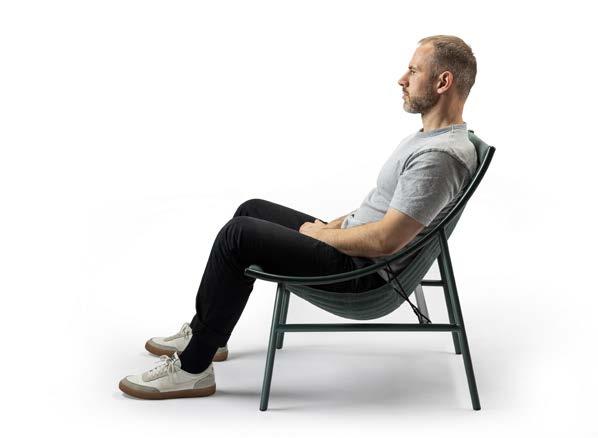
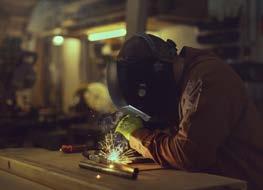
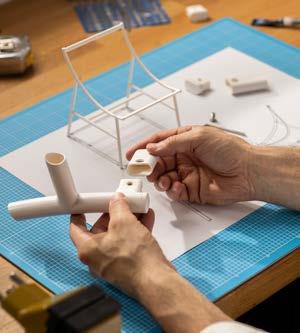
FLOOR_STORY HOSTED THE CAPTIVATING EXHIBITION “10 X 10”, A CELEBRATION OF TEN NEW RUG EDITIONS FROM SOME OF THEIR MOST ICONIC AND EXCITING COLLABORATORS. HELD AT FLOOR_ STORY’S OLD STREET SHOWROOM, THE EXHIBITION BROUGHT TOGETHER THE ENTIRE “10 X 10” SERIES FOR THE FIRST TIME, OFFERING A RARE OPPORTUNITY TO VIEW THESE BOLD AND INNOVATIVE WORKS IN ONE SPACE.
Known for its vibrant, daring designs and a strong commitment to craftsmanship, FLOOR_STORY, which recently achieved B Corp status, has built a reputation for pushing the boundaries of rug design. The brand’s first collaboration in 2014 with print and pattern expert Kangan Arora laid the foundation for what would become a series of over 30 collaborative collections, each reflecting a unique creative vision.
The “10 x 10” exhibition featured new editions designed in collaboration with celebrated names such as Henry Holland, Kangan Arora, Camille Walala, Adam Nathaniel Furman, Kitty Joseph, 2LG, John Booth, Gill Thorpe, Flock Studio, and Diane Bresson. Each designer brought their distinct style and personality to the collection, with fresh ideas, technologies, and influences clearly reflected in the new designs.
Booth is known for eclectic collaborations, from fashion brand Frescobol Carioca to Rosewood London. His rugs, including Giovanni, are uplifting and bring an optimistic atmosphere to any space, whether laid on the floor or hung as art.
The exhibition also explored the personal evolution of each designer, celebrating how their partnership with FLOOR_STORY has evolved over time. From their original collaborations to the present day, these new editions showcased experimentation in both colour and technique, highlighting the skill and craftsmanship involved in producing these complex, richly creative rugs.
Through “10 x 10,” FLOOR_STORY once again showcased its ability to curate a visually stunning, cohesive collection that pushes the boundaries of design while celebrating its collaborative spirit. The exhibition not only highlighted the craftsmanship behind each rug but also reinforced the brand’s role as a champion of bold, artistic expressions in the world of interiors.
A true highlight of the exhibition was John Booth’s Giovanni rug, showcasing his signature bold use of colour and quirky, illustrative style. Known for layering shapes and mark-making techniques, Booth creates a stunning balance of colour and texture. His Giovanni rug, produced exclusively for FLOOR_ STORY, captures this vibrant aesthetic in wool and silk, blending art with functionality. 10 X 10
